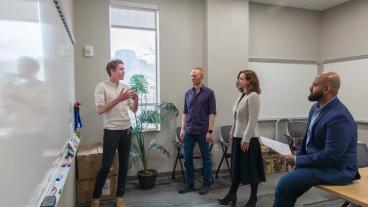It’s the first day of classes at Colorado School of Mines not just for students but also for new Provost Rick Holz.
In college, on the first day of school, there’s probably no one taking a cute photo of you with your backpack on, standing on the front stoop of your house.
But it got us thinking: What does a provost do on the first day of a new academic year?
We sat down with Dr. Holz to get the answer and learn more about his own journey as a scientist.
Q: Do you have a first day of school ritual?
A: I do not – other than trying to get here early enough to avoid traffic and be able to get a parking place. Generally, on the first day, I’m just ready by my email and phone to deal with any issues that pop up. In that first week of school, there's very little the provost does directly with launching the school year. We’re already in the process of recruiting our next class and planning for the next year and thinking about schedules. I’m looking at the next semester and the next year already. The faculty are the real first-day heroes.
Q: This is your “first” first day of classes as Mines provost. Why did you decide to join Mines?
A: The opportunity to come to Mines was just too good to pass up. A big reason I was interested in Mines was the Mines@150 strategic plan and the opportunity to work with President Johnson. There are so many opportunities for Mines, like developing new programs within our focus on earth, energy and environment. I was also very impressed with the campus and the vice presidents and all the faculty that I've met. The importance of STEM education across the country and the growth in job opportunities for graduates in STEM areas is just tremendous.
Q: How did you spend your first summer in Golden?
A: I spent most of the summer moving– both my house and my lab – and then doing house repairs. But my family and I have recently been able to get out and explore some places, like Mount Evans and Rocky Mountain National Park and Winter Park. We’re just captivated by the beauty of Colorado and the opportunity for being outdoors and the tremendous weather – although I was told in my interview that it never rained here in the summer. I think this was an unusual summer.
Q: How did you get into science and engineering?
A: Science has always been exciting for me – I like the challenge of it and the critical thinking component of it. I’ve always known since I was a little kid I would do something in the sciences, I just didn’t know what. When I started as an undergrad at Bemidji State, I wanted to be a forest ranger, but at the time, there just weren’t that many jobs for forest rangers. So, I switched my major to ichthyology, which is the study of fish, because I liked to fish. But when I took Invertebrate Anatomy, that killed that dream because I just didn’t like that course. It was all these Latin names you had to memorize, and it just wasn’t my thing. But I was taking chemistry all that time and I was doing quite well at it, so I decided to go with your strengths. I switched to become a chemist. When I took biochemistry as a senior, I really liked it.
Q: What’s the focus of your research?
A. I started out doing research on lanthanide ions – structure and bonding and spectroscopy – it’s a physical inorganic area of research and that’s what I did my master’s degree in. I continued with lanthanide chemistry but I moved more into biochemistry in my graduate work. We were utilizing lanthanide ions as spectroscopic probes in calcium proteins. I had enjoyed biochemistry as an undergrad and I wanted to learn more. In my postdoctoral work, I knew I needed a broader inorganic background than just lanthanide chemistry, so I did transition metal biochemistry, looking at metallo-enzymes that utilize a transition metal in order to catalyze a reaction. From that point forward, I've really been interested in mechanisms – how do these enzymes work? How do they catalyze these interesting reactions, with in many cases very unusual active site structures? That’s what I've done my entire career, mechanistic enzymology.
Q: What are the potential applications of that kind of work?
A: The things we’re working on right now have quite a few applications. We’re working on an enzyme called nitrile hydratase -- it converts nitriles to amides, a very important industrial reaction. It’s also an important pharmaceutical reaction. It’s not trivial to do in the laboratory. The best example is acrylonitrile. Acrylamide is used to form polyacrylamide. Polyacrylamide is found in carpets and clothing and plastics and it’s used in the petroleum industry. It’s got huge industrial uses. To do that reaction industrially requires high temperatures and a copper catalyst and there’s often other side products that are formed. It’s a messy reaction. With the enzyme we have catalyzes this reaction – the acrylonitrile-to-acrylamide reaction – at room temperature, at physiological pH, and it does it at 1,300-1,400 turnovers per second. It does it very fast and efficiently. We’re trying to figure out how this enzyme functions in order to either on our own develop small molecule catalysts that could be used for industrial purposes or provide information to others to synthetically replicate this reaction.
Another enzyme we’re working on actually removes a chlorine from a benzene ring and it does it in a hydrolytic process, which is very unusual. There are very few of these known. The substrate for this enzyme actually a very well-known fungicide – it’s one of the broadest utilized fungicides in the United States and around the world, but it’s also very toxic to aquatic species. It gets into the biomass in lakes and rivers and it’s consumed by invertebrates and it ends up being consumed by fish. Trying to understand how to degrade this fungicide by this enzyme, because it’s so widely used and is an environmental pollutant, is our goal.
Q: What are you looking forward to most during your first academic year at Mines?
A: What I’m looking forward to most is listening to the students and understanding what students would like to see happen at Mines. Because at the end of the day, everything I do or faculty do or even other administrative units at the university, it’s all about students and what we need to do to provide that transformative Mines education. Learning directly from the students as to what their hopes, desires, dreams, needs are and then how do we work as a team – department heads, faculty, vice provosts and myself along with the administrative side of the institution – in order to provide that transformative education, that’s what I’m most excited for.




